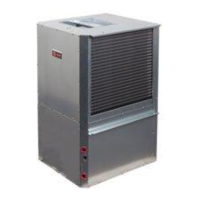SYSTEM CHECKOUT
After completing the installation, and before energizing the unit,
the following system checks should be made:
1. Verify that the supply voltage to the heat pump is in accor-
dance with the nameplate ratings.
2. Make sure that all electrical connections are tight and se-
cure.
3. Check the electrical fusing and wiring for the correct size.
ELECTRICAL SHOCK HAZARD
Failure to follow this warning could result in personal
injury or death.
Ensure cabinet and electrical box are properly grounded
4. Verify that the low voltage wiring between the thermostat
and the unit is correct.
5. Verify that the water piping is complete and correct.
6. Check that the water flow is correct, and adjust if necessary.
7. Check the blower for free rotation, and that it is secured to
the shaft.
8. Verify that vibration isolation has been provided.
9. Unit is serviceable. Be certain that all access panels are
secured in place.
Considerations:
• Always check incoming line voltage power supply and
secondary control voltage for adequacy. Transformer
primaries are dual tapped for 208 and 230 volts. Connect
the appropriate tap to ensure a minimum of 18 volts
secondary control voltage. 24 volts is ideal for best
operation.
• Long length thermostat and control wiring leads may
create voltage drop. Increase wire gauge or up-sized
transformers may be required to insure minimum
secondary voltage supply.
• The following guidelines are recommended for wiring
between a thermostat and the unit: 18 GA up to 60 foot, 16
GA up to 100 ft and 14 GA up to 140 ft.
• Do not apply additional controlled devices to the control
circuit power supply without consulting the factory. Doing
so may void equipment warranties.
• Check with all code authorities on requirements involving
condensate disposal/overflow protection criteria,
UNIT START-UP
NOTE: A unit Start-Up checklist is included in the unit packet.
Complete the Checklist and place it in the customer file at your
dealership.
1. Set the thermostat to the highest setting.
2. Set the thermostat system switch to "COOL", and the fan
switch to the "AUTO" position. The reversing valve
solenoid should energize. The compressor and fan should
not run.
3. Reduce the thermostat setting approximately 5 degrees
below room temperature.
4. Verify the heat pump is operating in the cooling mode.
5. Turn the thermostat system switch to the "OFF" position.
The unit should stop running and the reversing valve should
de-energize.
6. Leave the unit off for approximately five (5) minutes to
allow for system equalization.
7. Turn the thermostat to the lowest setting.
8. Set the thermostat switch to "HEAT".
9. Increase the thermostat setting approximately five (5)
degrees above room temperature.
10. Verify the heat pump is operating in the heating mode.
11. Set the thermostat to maintain desired space temperature.
12. Check for vibrations, leaks, etc.
MAINTENANCE
Filter changes or cleanings are required at regular intervals.
The time period between filter changes will depend upon
type of environment the equipment is used in.
In a single family home, that is not under construction,
changing or cleaning the filter every 60 days is sufficient. In
other applications such as motels, where daily vacuuming
produces a large amount of lint, filter changes may need to
be as frequent as biweekly.
UNIT DAMAGE AND/OR OPERATION HAZARD
Failure to follow this caution may result in unit damage
and/or improper equipment operation.
Equipment should never be used during construction due
to likelihood of wall board dust accumulation in the air
coil of the equipment which permanently affects the
performance and may shorten the life of the equipment.
2. An annual "checkup" is recommended by a licensed
refrigeration mechanic. Recording the performance
measurements of volts, amps, and water temperature
differences (both heating and cooling) is recommended.
This data should be compared to the information on the
unit's data plate and the data taken at the original startup of
the equipment.
3. Lubrication of the blower motor is not required, however
may be performed on some motors to extend motor life.
Use SAE-20 non-detergent electric motor oil.
4. The condensate drain should be checked annually by
cleaning and flushing to insure proper drainage.
5. Periodic lockouts are commonly caused by air or water flow
problems. The lockout (shutdown) of the unit is a normal
protective measure in the design of the equipment. If contin-
ual lockouts occur, call a mechanic immediately and have
them check for the following:
- Water flow problems
- Water temperature problems
- Air flow problems
- Air temperature problems.
Use of the pressure and temperature charts for the unit may
be required to properly determine the cause.
31

